Step into the biblical landscape to uncover the profound significance of the east, where divine beginnings and prophecy intertwine.
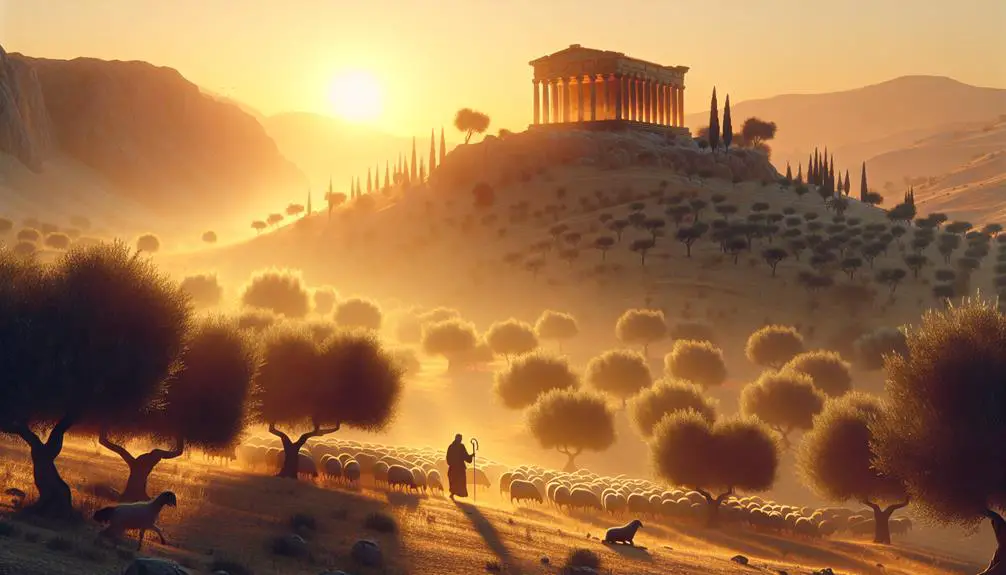
Significance of East in the Bible
Imagine the sun rising in the east, casting its first rays over ancient landscapes—a symbol deeply woven into the narrative fabric of the Bible.
You'll find the east isn't just a direction but a canvas for divine action, from the Garden of Eden to the prophetic visions of Ezekiel.
It's a marker of beginnings, divine presence, and eschatological hope.
As you explore this theme, you're stepping into a journey that transcends mere geography to touch on the very heart of faith and prophecy.
What revelations might unfold for you in understanding the east's profound significance?
Key Takeaways
- The east symbolizes divine presence, renewal, and promises of salvation in biblical narratives.
- Eastward journeys in the Bible represent movement towards redemption and encounters with the divine.
- In eschatology, the east is associated with new beginnings, divine interventions, and the fulfillment of God's promises.
- Sunrise and eastern winds in the Bible signify hope, divine intervention, and the dawning of a new era.
East in Creation's Story

In analyzing the narrative of creation, it's evident that the orientation towards the east plays a pivotal role in the biblical cosmology, symbolizing beginnings and divine presence. The Garden of Eden, as described, is situated in the east, marking the commencement of humanity's journey and its initial divine encounter. This garden location isn't merely geographical but imbues the narrative with layers of meaning, particularly emphasizing the sunrise significance.
You'll find that the east, where the sun rises, is synonymous with renewal, hope, and the dawn of God's creation. This is no arbitrary detail but a carefully chosen orientation that reflects the broader theological motifs of the Bible. The sunrise signifies not just the start of a new day but also the perpetual renewal of God's creation and His promises to humanity. It's as if each morning's light reaffirms God's ongoing presence and activity in the world.
The eastward positioning in the creation story thus serves as a powerful metaphor. It's not just about the physical light dispelling darkness but also about the spiritual light of God illuminating the path for humanity. This emphasis on the east and the sunrise underscores the conviction that life, guidance, and salvation emanate from God.
In this context, the Garden's location isn't a mere backdrop for mankind's origin tale but a profound statement about the nature of divine-human relationships. It suggests that to find one's purpose and to understand the world's order, one must look towards the divine light, symbolized by the east and the breaking dawn. This orientation sets a foundational tone for the unfolding biblical narrative, where the east continues to hold significant symbolic weight.
The Exodus and Eastward Journeys
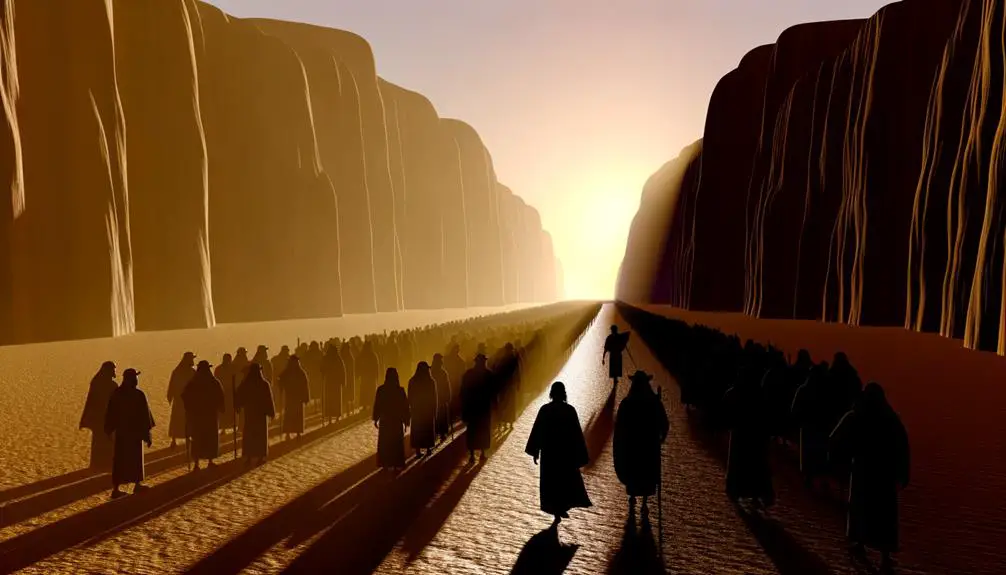
Moving beyond the serene beginnings in Eden, the narrative arc of the Bible shifts focus to pivotal eastward journeys, notably the Exodus, which further cements the east's symbolic importance in divine deliverance and new beginnings. The Exodus isn't just a tale of liberation; it's a profound exploration of faith amidst desert hardships and leadership challenges. This journey eastward becomes a crucible for transformation, both for Moses as a leader and for the Israelites as a people.
Your understanding of the Exodus isn't complete without recognizing the multifaceted challenges encountered. Desert hardships were not merely physical but also tested the Israelites' faith and reliance on God. Leadership challenges faced by Moses were unprecedented, involving not just guiding a multitude through hostile terrain but also mediating between them and the divine.
Here's a breakdown to enhance your understanding:
Aspect |
Description |
Significance |
|---|---|---|
Desert Hardships |
Extreme conditions testing survival and faith. |
Forged resilience and dependence on God. |
Leadership Challenges |
Moses' navigation through doubt, rebellion, and guidance. |
Highlighted the need for strong, divinely guided leadership. |
Eastward Journey |
Symbolic movement towards deliverance and new beginnings. |
Reinforced the east's role in divine narrative. |
This journey wasn't merely geographic but spiritual, moving towards a promised renewal. The east, in this context, isn't just a direction but a symbol of hope, challenge, and eventual redemption. The Exodus story, with its rich tapestry of desert hardships and leadership challenges, thus becomes a cornerstone in understanding the Bible's thematic depth.
East: Symbol of Divine Presence
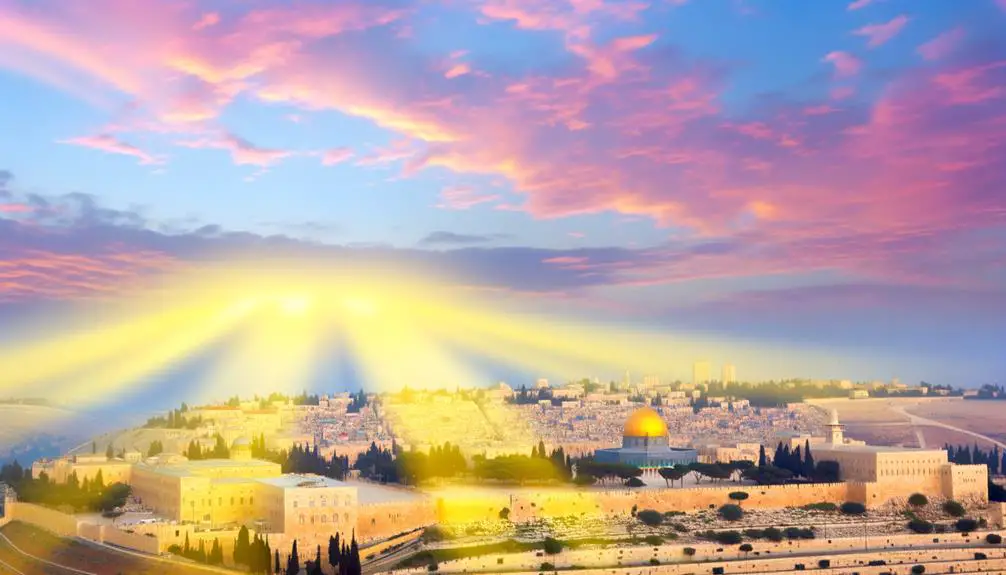
Throughout the biblical narrative, the east emerges as a profound symbol of divine presence, shaping the spiritual landscape of believers and their relationship with the divine. This direction isn't merely a compass point but a realm where the sacred and earthly planes intersect, offering a rich tapestry of symbolism and theological depth.
The significance of the east in the Bible can be distilled into several key elements:
- Eastern winds often signify change or divine intervention, illustrating how the forces of nature are at the command of the divine.
- Sunrise worship encapsulates the human longing for renewal and redemption, with the rising sun symbolizing hope and the promise of a new day under God's grace.
- The positioning of the Tabernacle and later the Temple, with their entrances facing east, underscores the importance of orienting one's life towards the divine presence.
- Biblical narratives frequently depict the east as a source of divine emanations, where God's glory is revealed or from where angels descend to interact with the human realm.
- The eastward journeys of key biblical figures often prefigure encounters with the divine or moments of significant spiritual revelation, reinforcing the east as a vector of divine engagement.
In this context, the east transcends its geographical connotation, embodying a profound spiritual symbol. It becomes a metaphor for seeking God, a direction from which divine wisdom and guidance emanate. Thus, understanding the biblical imagery associated with the east enriches one's appreciation of the intricate ways in which the divine presence is woven into the fabric of scriptural narratives.
Prophetic Visions and the East
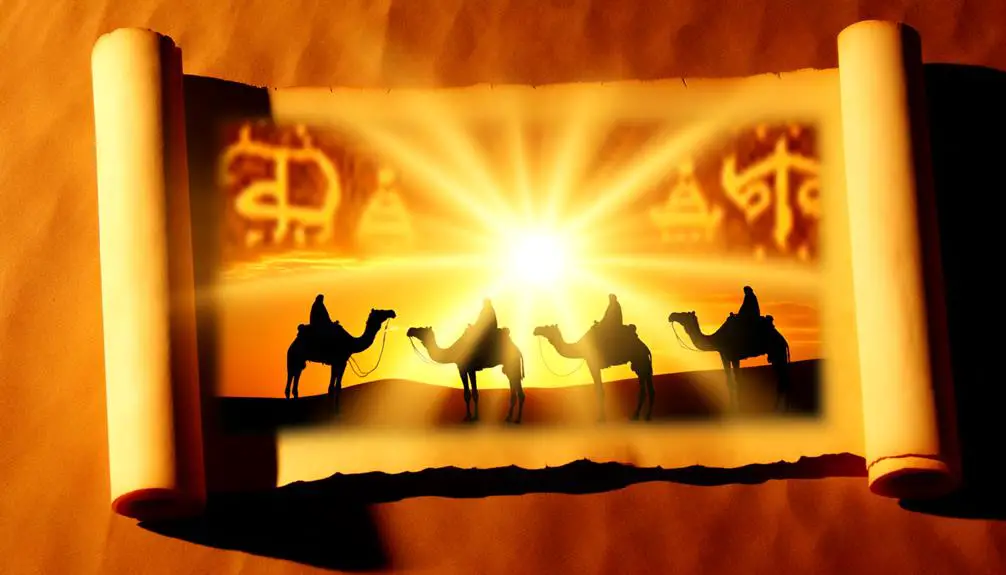
Building on the symbolic importance of the east in biblical narratives, let's explore its role in prophetic visions, where it often serves as a backdrop for divine revelations and eschatological promises. The east, with its association to the rising sun, symbolizes new beginnings and divine interventions. This celestial orientation plays a pivotal role in understanding the geographical and theological significance embedded in the prophetic literature.
Prophets often received their visions with eastern gateways as a key element, representing the path through which divine glory enters and exits the sacred spaces. These gateways aren't just architectural features but are imbued with deep symbolic meanings. They signify not only physical entry points but also spiritual access to divine presence and revelation. In the context of prophetic visions, eastern gateways symbolize both an invitation to divine encounter and a gateway to future promises.
Moreover, the emphasis on celestial orientations in these visions underlines the interconnectedness of cosmic order with divine plans. The prophets' attention to the east, therefore, transcends mere directional preference, highlighting a cosmologically anchored faith where heavenly bodies align with divine purposes. This celestial orientation invites believers to look beyond the physical realm, encouraging a deeper engagement with the spiritual dimensions of faith.
The East in Eschatology

In exploring the significance of the east in biblical eschatology, it's crucial to understand how this direction symbolizes not just physical locations but also the unfolding of divine promises and end-time events. The biblical narrative often employs the imagery of an Eastern sunrise to depict new beginnings, hope, and the dawning of God's kingdom. This isn't merely a poetic device but a deeply ingrained symbol within the tapestry of eschatological thought, where the east becomes a focal point for apocalyptic expectations and divine interventions.
To paint a clearer picture, consider the following aspects of the east in biblical eschatology:
- Eastern sunrise: Symbolizes the return of Christ and the dawn of a new age, where darkness is dispelled by the light of salvation.
- Apocalyptic imagery: Often situates pivotal eschatological events in the east, reinforcing its role as the stage for divine acts that fulfill ancient prophecies.
- Direction of divine appearance: Traditionally, the east is where God's presence is first manifested, signifying hope and renewal for the faithful.
- Location of Eden: Positioned in the east, Eden symbolizes the restored paradise that awaits believers, a key theme in eschatological promises.
- Gathering of the elect: Portrayed as coming from the east, among other directions, highlighting the universal scope of God's salvation plan and the gathering of believers from all corners of the earth.
Through these elements, the east in biblical eschatology isn't just a cardinal direction but a profound symbol of hope, restoration, and divine fulfillment, underscoring the anticipated culmination of God's redemptive history.
Frequently Asked Questions
How Has the Concept of "East" Influenced Christian Liturgical Practices and Church Architecture Throughout History?
In Christian liturgical practices and church architecture, the concept of 'east' has deeply influenced design and ritual.
You'll find churches traditionally oriented with the altar facing east, embodying orientation symbolism. This alignment invites the congregation to pray towards the rising sun, reflecting renewal and Christ's resurrection.
Moreover, sunrise services, especially on Easter, hold profound significance, as they're held at dawn facing east, symbolizing hope and the light of Christ entering the world.
In What Ways Did the Interpretation of "East" Differ Among Various Early Christian Sects or Denominations?
Diving into early Christianity, you'll find the interpretation of 'east' was a mosaic of beliefs. Sectarian geography played a pivotal role, with each sect weaving its unique tapestry of East symbolism.
While some saw it as a beacon of resurrection and renewal, others interpreted it as the direction of divine presence. This diversity in thought showcases the rich, analytical depth of early Christian denominations, each painting the 'east' with their own scholarly brushstrokes.
Are There Any Notable Differences in the Symbolic Meaning of "East" Between the Bible and Other Religious Texts From the Near East?
When you compare the Bible to other religious texts from the Near East, you'll notice some distinct differences in how 'east' is symbolized. Eastern metaphors and sunrise symbolism often carry unique connotations across these texts.
In the Bible, 'east' frequently embodies themes of beginnings and divine presence. Meanwhile, in other Near Eastern texts, these symbols might align more with rebirth or enlightenment. This variation highlights the rich tapestry of cultural and religious interpretations surrounding the concept of 'east.'
How Have Modern Archaeological Findings in the Near East Contributed to Our Understanding of Biblical Narratives Related to the East?
Modern archaeological findings in the Near East have shed light on biblical narratives, particularly those related to desert navigation and trade routes. You'll find that excavations have uncovered ancient roads and paths that align with descriptions found in biblical texts.
These discoveries not only confirm historical accounts but also provide a richer context for understanding the movements and interactions of biblical figures. They've deepened your comprehension of how geography influenced pivotal biblical events.
Can the Emphasis on the East in the Bible Be Linked to Specific Geographic or Cultural Reasons in the Ancient Near Eastern Context?
You're diving into why the east holds such weight, aren't you? Think of it as more than direction—it's drenched in solar symbolism, marking new beginnings and divine presence.
This region wasn't just spiritually significant; it was a hub for ancient trade routes, weaving cultures and economies together.
Conclusion
In your exploration of the Bible, you've seen how the East isn't just a direction; it's a profound symbol. From creation to eschatology, the East embodies divine presence and prophetic visions. Interestingly, over 70 references to the East in the Bible highlight its significance across various narratives.
This statistic underlines the East's pivotal role in biblical contexts, serving as a beacon for divine revelation and eschatological hope. By understanding the East's symbolism, you gain deeper insights into biblical themes and God's relationship with humanity.


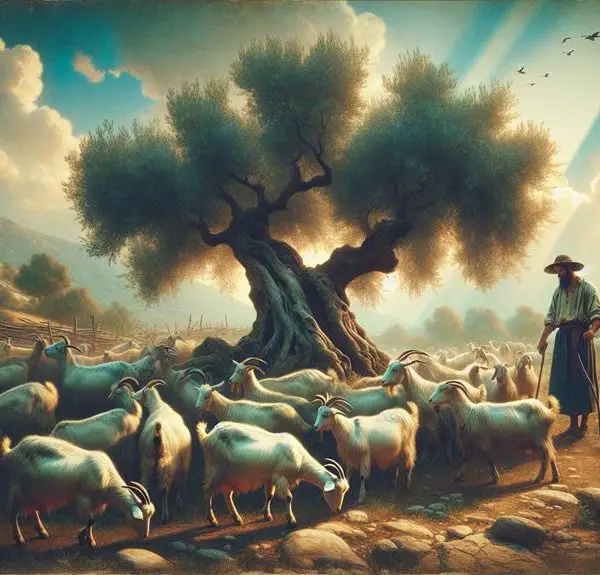
Sign up